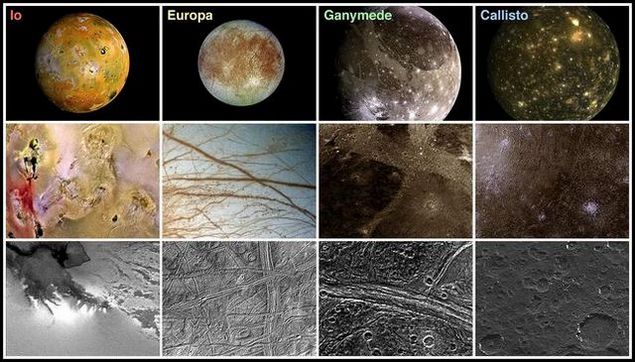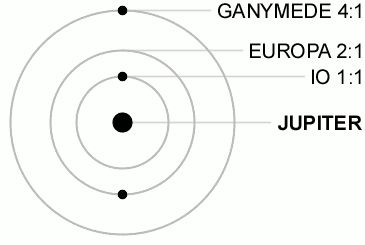The Galilean moons are the four largest moons of Jupiter Io, Europa, Ganymede, and Callisto. They were discovered by Galileo Galilei around January 1610 and were the first group of objects found to orbit another planet. Their names derive from the lovers of Zeus. They are among the most massive objects in the Solar System with the exception of the Sun and the eight planets, with radii larger than any of the dwarf planets. Ganymede is the largest moon in the Solar System, and is even bigger than the planet Mercury.

The three inner moons Io, Europa, and Ganymede are in a 4:2:1 orbital resonance with each other. Fluctuations in the orbits of the moons indicate that their mean density decreases with distance from Jupiter. Callisto, the outermost and least dense of the four, has a density intermediate between ice and rock whereas Io, the innermost and densest moon, has a density intermediate between rock and iron.

Callisto has an ancient, heavily-cratered and unaltered ice surface and the way it rotates indicates that its density is equally distributed, suggesting that it has no rocky or metallic core but consists of a homogeneous mix of rock and ice.
Fof more info please visit the wikipedia.org
IO
With over 400 active volcanoes, Io is the most geologically active object in the Solar System.This extreme geologic activity is the result of tidal heating from friction generated within Io's interior as it is pulled between Jupiter and the other Galilean satellites—Europa, Ganymede and Callisto. Several volcanoes produce plumes of sulfur and sulfur dioxide that climb as high as 500 km (300 mi) above the surface. Io's surface is also dotted with more than 100 mountains that have been uplifted by extensive compression at the base of Io's silicate crust. Some of these peaks are taller than Mount Everest. Unlike most satellites in the outer Solar System, which are mostly composed of water ice, Io is primarily composed of silicate rock surrounding a molten iron or iron sulfide core. Most of Io's surface is composed of extensive plains coated with sulfur and sulfur dioxide frost.

Io's volcanism is responsible for many of its unique features. Its volcanic plumes and lava flows produce large surface changes and paint the surface in various subtle shades of yellow, red, white, black, and green, largely due to allotropes and compounds of sulfur. Numerous extensive lava flows, several more than 500 km (300 mi) in length, also mark the surface. The materials produced by this volcanism make up Io's thin, patchy atmosphere and Jupiter's extensive magnetosphere. Io's volcanic ejecta also produce a large plasma torus around Jupiter.
IO: detailed specification and data
SAFETY WARNINGS
Terrain specified in the header corresponds to the real situation in terrain of the cache placement. Please consider your options, capabilities weather conditions. Remember that the safety is in first place in all circumstances. All you are doing is on your own risk, the author assumes no responsibility. Please protect the nature.
BEZPEČNOSTNÍ UPOZORNĚNÍ
Terén uvedený v záhlaví odpovídá skutečnému uložení krabičky a proto prosím zvažte vaše možnosti, schopnosti, povětrnostní podmínky. Pamatujte že bezpečnost je až na prvním místě. Kešku lovíte na vlastní nebezpečí, autor nenese žádnou odpovědnost. K přírodě se chovejte ohleduplně a neničte ji.